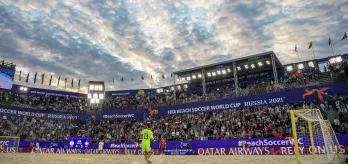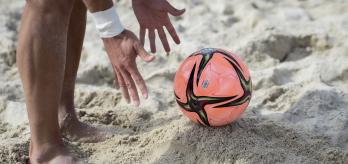Organisation
-
Set up 2 ball stations on the goal line, 1 level with each corner area. Divide the players between the 2 stations.
-
Place a cone at the imaginary halfway line opposite each station. Position a player at each cone.
-
Place a player on the edge of the the penalty area, who attempts to score with a bicycle kick.
Explanation
-
The players stationed at the imaginary halfway line receive a pass from the station opposite them. They must bring the ball under control and play a pass along the ground to the attacker on the edge of the area, who should trap the ball before flicking it up off the sand and shooting at goal with a bicycle or scissors kick.
-
After flicking the ball up, the attacker may take a further 1 or 2 touches to set themselves and perform the bicycle kick.
-
Rotate stations: once a player has taken their shot, they join the back of the queue at the opposite starting station from where they started. The players at the imaginary halfway line and the starting station follow their passes to take up their next position.
Variations
-
The players stationed at the imaginary halfway line play passes in the air to the attacker on the edge of the area, who should trap the ball before flicking it up off the sand and shooting.
-
After flicking the ball up, the attacker may only take 1 touch to shoot at goal.
Coaching points
-
The attacker should flick the ball up as high as possible to perform the bicycle or scissors kick.
-
The attacker should adjust their body position to set themselves for the shot.
-
If needed, the attacker may take a further 1 or 2 touches after flicking the ball up to set themselves for the shot.
-
Emphasise the importance of quality and accurate passes to give the attacker the best‑possible chance to score.
-
The top‑performing players in this exercise can be used as an example for the others.



























